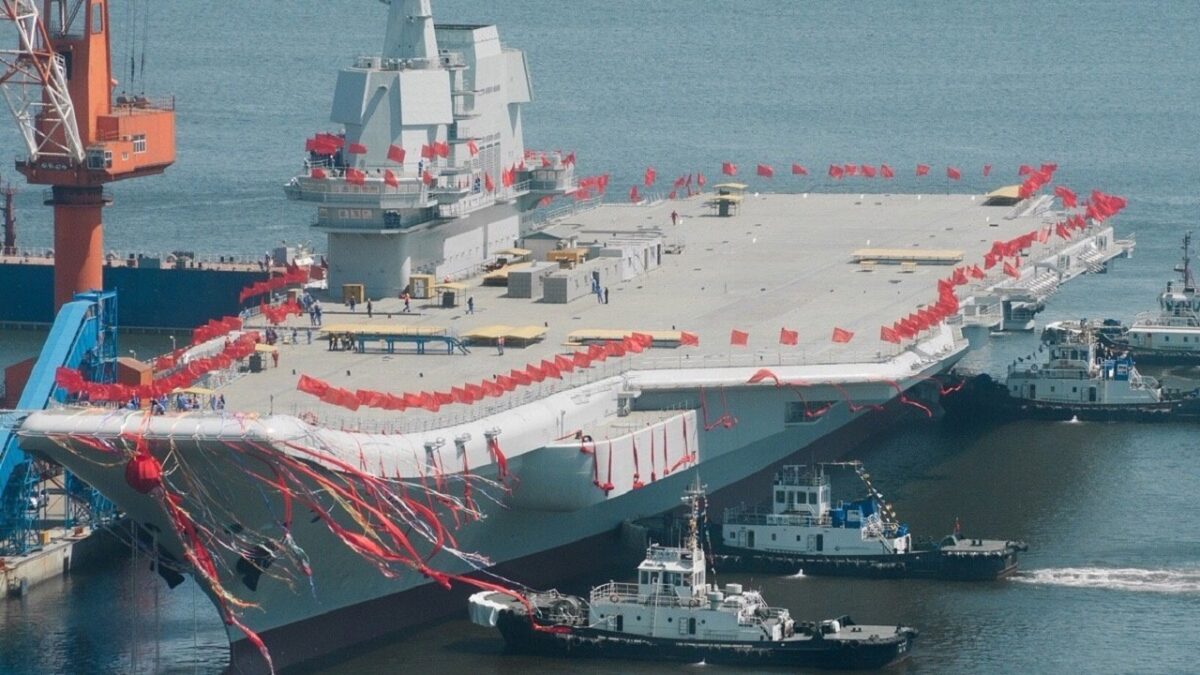Look Out for the Launch of China’s Latest Type 003 Aircraft Carrier – China’s newest aircraft carrier, which has been under construction since 2018, may launch this summer. New satellite imagery has been revealed by private-sector sources that show the Type 003 carrier’s drydock could be flooded soon – a step that puts the vessel closer to leaving the shipyard.
This would be a substantial leap forward for the People’s Liberation Army Navy’s (PLAN) shipbuilding program and a morale boost to China’s military strategists and the country’s defense industrial base.
Peek at Satellite Imagery Shows Type 003 Nearing Launch Date
The Associated Press analyzed images from Planet Labs PBC on June 3 to determine whether the work on the carrier is finished at the Jiangnan Shipyard northeast of Shanghai.
The photos taken on May 31 make it appear that the vessel is nearing completion.
Of course, the launch of the carrier is the start of a long journey before the PLAN can conduct regular operations.
There will be at least two years of testing and sea trials ahead of the ship. But the construction status is a shot in the arm for the PLAN which operates two other carriers – the Liaoning and Shandong.
Additional Clues Are Apparent
The Type 003 had to endure delays due to a Covid-19 flare-up in Shanghai, but it appears work is currently advancing. The Center for Strategic and International Studies (CSIS), a defense-related think tank in Washington, DC, also gleaned clues from the overhead imagery.
CSIS is watching for telltale signals the work is consummated and the dry dock is ready for launch. “The staircases that workers use to access the carrier—as well as the support structures and other equipment that skirt the ship—will need to be removed. The caisson, which segments the dry dock and allows work to proceed simultaneously on multiple vessels, will also be opened to allow water to fill the entire dry dock,” analysts at CSIS wrote on June 2.
Airplanes With More Fuel, Range, and Heavier Payloads to Deploy
The Type 003 is the PLAN’s largest carrier displacing between 85,000 and 100,000 tons. Unlike the ski-jump style the Liaoning and Shandong use to launch short-take off and vertical launch airplanes, the Type 003 will have a modern flat-top with electromagnetic catapults. This would mean more sorties with the ability to launch heavier and advanced airplanes such as newer fighter jets, anti-submarine aircraft, and command and control airplanes. FC-31 Gyrfalcon stealth fighters and J-15 carrier-based fighter jets have been spotted rehearsing for flat-top operations at the Chinese flight training area in Liaoning province.
China Is Getting a Warm-Fuzzy Feeling
China has to be tickled with the Type 003. There have been some recent delays as China watchers predicted it would have launched by now, but that triumphant day will come soon enough. The PLAN will likely speed up training for airplanes to be launched by modern catapults and arrested on flat-tops. The sea trials could take longer than two years, but once it hits the water, China can milk the public relations effect for all it is worth.
More Robust Naval Strategy
Once the Type 003 goes to the PLAN for full deployment, it is possible that China could put three different carrier battle groups in the water at the same time.
Although, they will find out that carriers require substantial maintenance time that reduces their time at sea. Despite these limitations, the development of the Type 003, shows the country’s seriousness at becoming a global naval power.
China is one of the world’s best, if not the best, commercial and military shipbuilder. They seem to have a whole of government approach to ship construction that just pumps out the vessels.
Meanwhile, Congress, the Pentagon, and the White House appear to be divided on naval strategy and do not agree on how many ships the U.S. Navy should utilize. Some American policymakers believe certain ships should be retired, while others advocate for increasing the numbers of vessels.
China’s carrier force will have several adversaries that it can focus on to show off its prowess – the United States, Taiwan, Japan, and Australia. The Americans are likely to keep two carrier battle groups in the East and the South China Sea permanently, which is an expensive and high-tempo proposition. Taiwan and Japan will see more incursions into their air defense identification zones and Australia may witness additional intercepts of their airplanes by Chinese craft.

Image Credit: Creative Commons.

Fujian, China’s New Aircraft Carrier. Image Credit: Chinese Internet.

Fujian, China’s new aircraft carrier. Image Credit: Chinese Internet.
China will relish these confrontations and the Type 003 will be a welcome addition to their fleet.
Now serving as 1945’s Defense and National Security Editor, Brent M. Eastwood, PhD, is the author of Humans, Machines, and Data: Future Trends in Warfare. He is an Emerging Threats expert and former U.S. Army Infantry officer. You can follow him on Twitter @BMEastwood.

